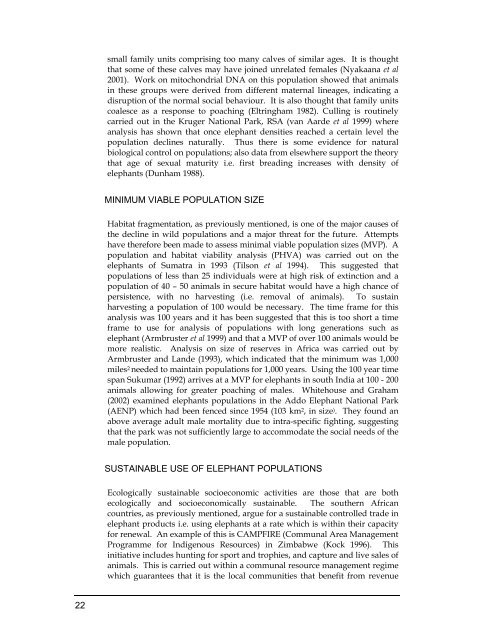Elephants Elephants - Wildpro - Twycross Zoo
Elephants Elephants - Wildpro - Twycross Zoo
Elephants Elephants - Wildpro - Twycross Zoo
Create successful ePaper yourself
Turn your PDF publications into a flip-book with our unique Google optimized e-Paper software.
22<br />
small family units comprising too many calves of similar ages. It is thought<br />
that some of these calves may have joined unrelated females (Nyakaana et al<br />
2001). Work on mitochondrial DNA on this population showed that animals<br />
in these groups were derived from different maternal lineages, indicating a<br />
disruption of the normal social behaviour. It is also thought that family units<br />
coalesce as a response to poaching (Eltringham 1982). Culling is routinely<br />
carried out in the Kruger National Park, RSA (van Aarde et al 1999) where<br />
analysis has shown that once elephant densities reached a certain level the<br />
population declines naturally. Thus there is some evidence for natural<br />
biological control on populations; also data from elsewhere support the theory<br />
that age of sexual maturity i.e. first breading increases with density of<br />
elephants (Dunham 1988).<br />
MINIMUM VIABLE POPULATION SIZE<br />
Habitat fragmentation, as previously mentioned, is one of the major causes of<br />
the decline in wild populations and a major threat for the future. Attempts<br />
have therefore been made to assess minimal viable population sizes (MVP). A<br />
population and habitat viability analysis (PHVA) was carried out on the<br />
elephants of Sumatra in 1993 (Tilson et al 1994). This suggested that<br />
populations of less than 25 individuals were at high risk of extinction and a<br />
population of 40 – 50 animals in secure habitat would have a high chance of<br />
persistence, with no harvesting (i.e. removal of animals). To sustain<br />
harvesting a population of 100 would be necessary. The time frame for this<br />
analysis was 100 years and it has been suggested that this is too short a time<br />
frame to use for analysis of populations with long generations such as<br />
elephant (Armbruster et al 1999) and that a MVP of over 100 animals would be<br />
more realistic. Analysis on size of reserves in Africa was carried out by<br />
Armbruster and Lande (1993), which indicated that the minimum was 1,000<br />
miles 2 needed to maintain populations for 1,000 years. Using the 100 year time<br />
span Sukumar (1992) arrives at a MVP for elephants in south India at 100 - 200<br />
animals allowing for greater poaching of males. Whitehouse and Graham<br />
(2002) examined elephants populations in the Addo Elephant National Park<br />
(AENP) which had been fenced since 1954 (103 km 2, in size ). They found an<br />
above average adult male mortality due to intra-specific fighting, suggesting<br />
that the park was not sufficiently large to accommodate the social needs of the<br />
male population.<br />
SUSTAINABLE USE OF ELEPHANT POPULATIONS<br />
Ecologically sustainable socioeconomic activities are those that are both<br />
ecologically and socioeconomically sustainable. The southern African<br />
countries, as previously mentioned, argue for a sustainable controlled trade in<br />
elephant products i.e. using elephants at a rate which is within their capacity<br />
for renewal. An example of this is CAMPFIRE (Communal Area Management<br />
Programme for Indigenous Resources) in Zimbabwe (Kock 1996). This<br />
initiative includes hunting for sport and trophies, and capture and live sales of<br />
animals. This is carried out within a communal resource management regime<br />
which guarantees that it is the local communities that benefit from revenue

















